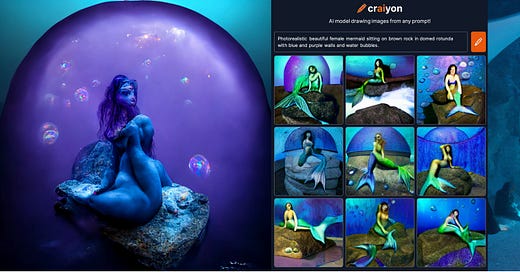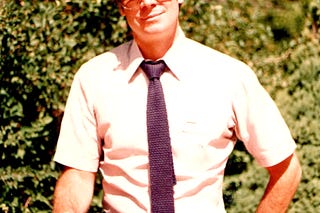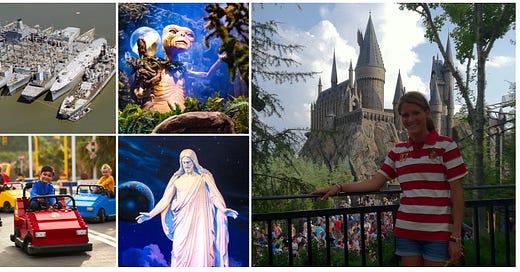

Discover more from Creative Leadership
The Future of Design Belongs to All of Us
Some say AI will make us dumber, but what if the opposite is true?
We are not designers and yet the future of design belongs to us.
With the help of artificial intelligent design tools like DALL·E 2, Midjourney and Craiyon, we now have the tools, albeit still somewhat crude, to ensure that our ideas can be visualized with the power of words.
Yes, our words.
In the era of scrolling through Instagram Reels, TikTok and YouTube videos, how sweet it is that the future belongs to anyone who can write, with their words constantly flowing into these online AI design engines as they spit out thousands of new visuals every minute. It’s only a matter of time before words will inspire millions of designs per second.
To understand the seismic shift happening under our feet, we can compare the old world with this brave new world by looking at a common business practice repeated every day throughout the world—a brainstorming meeting, or as we call it in our industry, a charrette.
In yesterday’s charrette, the only people in the room who could get their pencils, markers or iPads out to visualize the ideas being brainstormed were the designers. As a writer, producer, project manager, engineer or whatever, you were stuck there at the conference table with your Field Notes or MacBook scribbling your thoughts down while the designers in the room sketched away. The best designers might even hop up to the white marker board and begin visualizing a rough concept.
Yesterday, we were not designers.
Today, in this new world, anyone in the charrette can simply open up Midjourney and articulate their idea in a few words: /imagine mermaid sitting on rock in domed underwater cave full of bubbles with blue and purple hues, with a wide angle lens.
As images begin to populate, this new designer might think. “Intriguing, but a bit creepy. No, that’s not exactly what I was seeing in my head.”
No worries, with the help of AI, our new designer can simply edit their idea and try again on Craiyon: A beautiful mermaid with blonde hair sitting on a brown rock inside a large domed underwater cave full of bubbles with blue and purple hues.
“Hmmm… That’s still not quite right, but it’s getting closer…”
If lucky, our new designer can now try what many consider to be the most robust of the AI design tools—and certainly the hardest to get access to—DALL·E 2. You can then use its variation tool that allows you to upload pre-existing images and alter them. Click “upscale” and now you can airdrop them to your iPhone and share the design with the rest of those in the charrette.
“Hey everyone, this is what I have in mind for the mermaid attraction’s entrance?”
Congratulations. Everyone in that charrette is now a designer.
Now, this doesn’t mean you won’t need a human designer to elevate your new concept. In fact, you can see what a designer can do to elevate that mermaid design in this rendering, “Hey Zoe, can you design a mermaid sitting on a rock inside an underwater sea cave?”
Yes, AI design is crude and imperfect. Even as it improves, we do not believe it will ever replace the human creative touch even though there are those who think it might. As a tweet we saw last week by Chris Bakke said:
“Dall-E: will replace designers. Copilot: will replace engineers. OpenAI: will replace copywriters. Project Managers are safe because AI can’t sit poolside drinking margaritas while giving thumbs up emojis in Slack yet.”
In the end, creativity, whether its AI, advanced 3D printing or even EDM machines, can be mimicked but it can never be automated.
In fact, AI design requires more creativity as everyone learns how to design through their own words. While these AI design tools will change our work in ways that are difficult to fathom, the most important change will be in requiring everyone to write and think carefully about words—something we should be doing anyway.
What’s the difference between misty and cloudy?
Is it better to describe something as ethereal or delicate?
How will the design change if I describe it as epic?
Of course, we’ll also need to spend much more time studying history and design because there is a difference between Spanish Colonial and Mission Revival architecture or Desert Modernism and Mid-century Modern.
Do you know the difference between the aesthetic of Blade Runner and Star Wars?
Imagine the fun in laboring over the difference between pink and fuchsia.
Some critics are lamenting, as a headline pronounced in Forbes earlier this year, that…
“Artificial Intelligence Can Kill Creativity And Make Us Dumber.”
However, what if the opposite is true? What if AI design tools force us to learn how to write again? As any good writer knows, the only way to learn how to write is to understand what you are writing about through research and study. The only way to become a better writer is to read and write more. Writers can often generate the world’s best ideas because writing is, in and of itself, a creative process. Even the scientific data proclaims that writing makes people smarter.
And for those who care more about celebrity than getting smarter, well, there is hope for you too. Because AI will make all of us designers, a few of us can perhaps finally become famous. In design, it’s not the person who wrote the creative briefs that were handed to the architects of the Vontz Center for Molecular Studies, the Engineering Research Center and the Campus Recreation Center at the University of Cincinnati that became famous.
However, we all know Frank Gehry, Michael Graves and Thom Mayne.
And it’s the same in technology. We don’t know who Tony Fadell and Scott Forstall are, but most people know Jony Ive designed Apple’s iPhone even though Tony and Scott’s contributions as its engineers were arguably much greater.
In our work, we help create theme park attractions, museum exhibits and brand experiences. In this industry, there are three types of people. Writers. Designers. Producers. In other words, there are the people who craft the stories. Those who visualize the stories. And, of course, the people who transform those stories and concepts into reality. All three are necessary and will continue to be necessary, but aren’t we all just a little jealous of the designers?
Yes, we know who the rock stars are and they are all designers.
All you have to do is pick up a proverbial magazine to see that designers are more popular than writers. While browsing through WIRED, FastCompany, I.D., Creative, Forbes, AdAge, Fortune and Print in an airport bookstore recently (that’s pretty much the only place where you can still find real magazines), we found article after article about the power of design. As we we read in AdAge:
“Design has become the critical weapon for marketers to wield in an era of ever more sophisticated and style-conscious consumers.”
We’ve never seen a cover story on writing. You will never see business reporters proclaiming writers as “masters,” “gods” and “gurus” as they have about designers. Even in Hollywood, few people know who wrote the words spoken between Maverick and Iceman in this year’s biggest blockbuster.
A CEO who can write a great white paper or DM isn’t sexy.
Until now.
In the posts we see about these AI design tools, most people are focusing on whether and/or how artificial intelligence will change design. And there’s no doubt it will change how designers work in ways we cannot predict. However, we believe the biggest disruption isn’t in the process of design but in what these tools will deliver to everyone else.
Thanks to artificial intelligence, we are all designers now.
Geoff Thatcher and Dominic Cardoso worked together on the launch of ATOM, a new animatronic for the themed entertainment industry from Animax and have been experimenting with these new AI design tools for the past three weeks.













